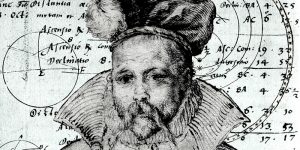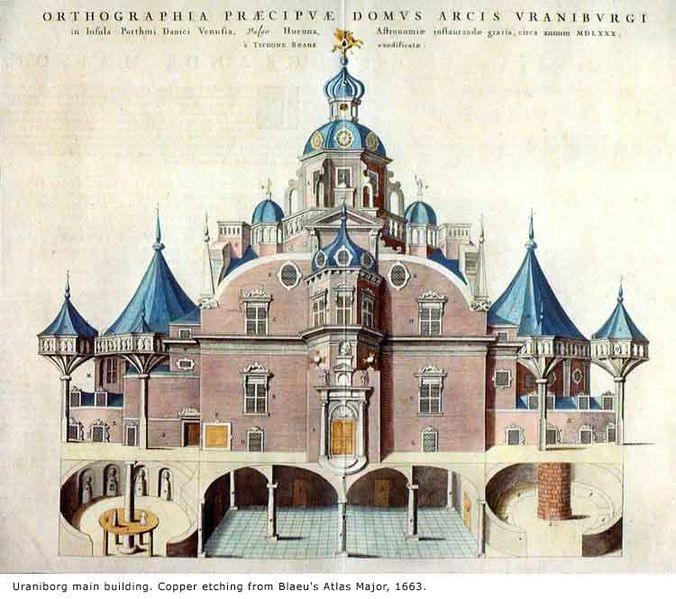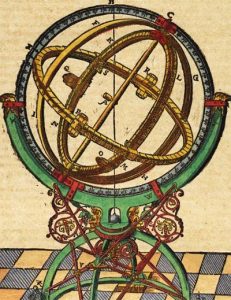
December 14, 1546. Today is Tycho Brahe’s 470th birthday. He was so influential that many astronomers today call him simply Tycho. We remember him for his golden nose, and for his highly accurate measurements of the positions of the planets and of over 777 fixed stars. Later, Tycho’s assistant, Johannes Kepler, used his master’s planet and star measurements to revolutionize physics and astronomy with his three laws of planetary motion.
Tycho was born shortly before the invention of telescopes, in Denmark, on December 14, 1546. He grew up with his wealthy uncle who paid for his education in law at the University of Copenhagen from 1559 to 1562. On August 21, 1560, a total eclipse of the sun diverted Tycho’s course toward astronomy. The 14-year-old Tycho was said to be amazed beyond words, and his passion for astronomy was born. From that day, Tycho divided his time between law, to accommodate his uncle’s wishes, and astronomy to satisfy his own curiosity. His mathematics professor helped him with the only astronomy book available: one of Ptolemy’s works describing the geocentric – or Earth-centered – model of the universe.
After he finished his studies at the University of Copenhagen, Tycho’s uncle sent him to the University of Leipzig for more studies until 1565. In 1563, Tycho made his first recoded astronomical observation, of the conjunction of Jupiter and Saturn. Shortly afterwards, he found out that such events were already predicted in various almanacs, but, at that time, were extremely inaccurate. He decided to devote himself to correcting the existing predictions.
It was in 1566, while dueling with swords with his third cousin, that Tycho lost part of his nose. Afterwards, he wore a metal prosthetic nose.
For the next five years, after completing his studies, he travelled across Europe and collected instruments for astronomical observation. Around 1571, after inheriting from his uncle and father, Tycho settled in a castle on what’s now an island of Sweden. A few years later, he constructed a small and now-famous observatory that he called Uraniborg, as a tribute to Urania, the Muse of Astronomy.

Tycho used his money on things other than astronomy. If he’d lived in modern times, he’d have been called a party animal and had regular guests with whom to drink. He even had a jester. Some say he also had a tame elk who died from falling down the stairs after drinking too much beer.
On November 11, 1572, the most amazing event happened in front of Tycho’s eyes: he saw a new star appear, shining more brightly than than the sky’s third-brightest object (after the sun and moon), the planet Venus. The “new” star appears in the direction to the constellation Cassiopeia the Queen. He wrote:
When, according to my habit, I was contemplating the stars in a clear sky, I noticed that a new and unusual star, surpassing the other stars in brilliancy, was shining almost directly above my head. And since I had almost from boyhood known all the stars of the heavens perfectly . . . it was quite evident to me that there had never before been any star in that place in the sky, even the smallest, to say nothing of a star so conspicuously bright as this. I was so astonished at this sight that I was not ashamed to doubt the trustworthiness of my own eyes.
This was a very worrisome prospect for his time, when the sky was supposed to be a symbol for perfection and constancy. In addition to this new star, Copernican Theory already rattled the ideology of the time. This event was the subject of Tycho’s first paper that confirmed his capability as an astronomer. He wrote:
I conclude, therefore, that this star is not some kind of comet or a fiery meteor… but that it is a star shining in the firmament itself – one that has never previously been seen before our time, in any age since the beginning of the world.
Today, we know this star was a supernova, one of the very few seen in recorded history. In honor of the great astronomer whose mind so openly accepted it, the supernova of 1572 is sometimes called Tycho’s Star.

Throughout his life, Brahe was also an artist. He loved making things, such as his astronomical instruments, look beautiful. Above is his plan for an armillary, an instrument used to measure the positions of celestial objects. The circles are divided into degrees. Notice the amount of detail and decoration.
It was around 1600, a year before Tycho’s death, that Kepler entered the picture. Kepler believed in Copernican theory and was trying to explain planetary motion, especially the issue with the retrograde motion of Mars. Kepler understood that he needed the most accurate measurement to figure out this puzzle and so he set out to see Tycho and obtain them.
Tycho wasn’t very cooperative at first. In fact, the two weren’t getting along very well. Kepler was finally able to get his hands on Tycho’s observations (it is unclear how, some say he might have stolen them).
He used them to devise his three laws of planetary motion, which became the groundwork for later revelations about gravity by Isaac Newton.
Learn more about Tycho’s relationship with Kepler in this episode of Carl Sagan’s Cosmos series.
Tycho died in 1600 due to a bladder issue. The circumstances around his death were strange, some say … as strange as his life as a whole.

Bottom line: Tycho Brahe was born 470 years ago today. He is remembered for his unique character and for accurate measurements of the positions of stars and planets. His work was later used by Johannes Kepler to devise his three laws of planetary motion.











